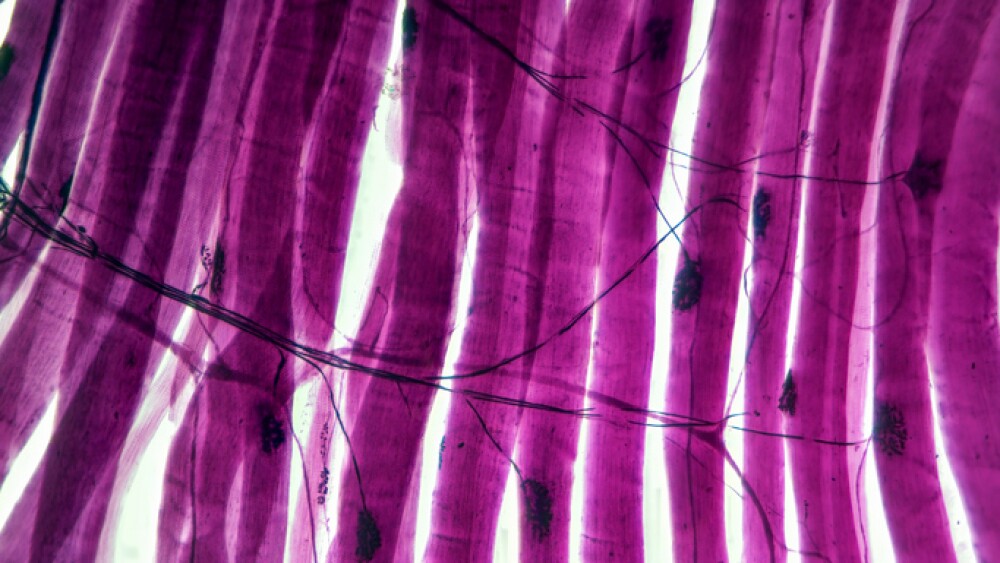AngioDynamics, Inc. (NASDAQ: ANGO) today announced that results from the Acute Pulmonary Embolism Extraction Trial with the AlphaVac System (APEX-AV) were presented at The Society for Cardiovascular Angiography & Interventions (SCAI) 2024 Scientific Sessions hosted in Long Beach, California on May 3, 2024.
New data finds AlphaVac F1885 System safe in patients with acute intermediate-risk pulmonary embolism (PE) and provides significant improvement in right ventricular function and reduction in clot burden
LATHAM, N.Y.--(BUSINESS WIRE)-- AngioDynamics, Inc. (NASDAQ: ANGO), a leading and transformative medical technology company focused on restoring healthy blood flow in the body’s vascular system, expanding cancer treatment options and improving patient quality of life, today announced that results from the Acute Pulmonary Embolism Extraction Trial with the AlphaVac System (APEX-AV) were presented at The Society for Cardiovascular Angiography & Interventions (SCAI) 2024 Scientific Sessions hosted in Long Beach, California on May 3, 2024.
Co-Principal Investigator William Brent Keeling, MD, Associate Professor of Surgery, Department of Surgery, at the Emory University School of Medicine, and Immediate Past President, The PERT Consortium™, gave a presentation titled “Evaluating the safety and efficacy of the AlphaVac F1885 System in acute intermediate risk PE patients: APEX-AV trial” as part of the of the featured clinical research session.
The APEX-AV trial showed a mean decrease in the RV/LV ratio from baseline to 48 hours post-procedure of 0.45 (significantly greater than the pre-defined performance goal of 0.12 (p < 0.001)) and a Major Adverse Event (MAEs) rate of 4.1% (significantly lower than the pre-defined performance goal of 25% (p < 0.001)). The study also showed a 35.5% mean reduction in clot burden from baseline to 48 hours post-procedure1 and a mean procedure time of 37.2 minutes.1
“The impressive reduction in clot burden, in addition to the safety and efficacy results observed in the APEX-AV trial, underscore the importance of integrating this technology into the treatment of acute PE,” said Dr. Keeling. “Pulmonary emboli can be extremely dangerous and require effective and prompt action. We thank SCAI for the opportunity to share the study findings in detail.”
PE affects approximately 900,000 people in the United States every year and is the third leading cause of cardiovascular mortality in the nation.2,3 Patients with sub-massive or intermediate-risk PE account for 35% to 55% of hospitalized patients with PE and have a mortality rate of 3% to 14%.3,4
In December 2023, AngioDynamics announced the completion of patient enrollment in its APEX-AV trial, a single-arm Investigational Device Exemption study that enrolled 122 patients with confirmed acute, intermediate-risk PE across 25 hospital-based sites in the United States to assess the AlphaVac F18⁸⁵ System for the treatment of PE. In April 2024, the United States Food and Drug Administration (FDA) cleared the AlphaVac F1885 System for the treatment of PE.
“The results of the trial highlight the unique features of the AlphaVac device,” said Juan Carlos Serna, AngioDynamics Senior Vice President of Scientific and Clinical Affairs. “The reduction in clot burden of 35.5% compares favorably to the 9.3% reduction reported in the current market leader’s IDE data. The mean procedure time was 37 minutes compared to 57 minutes as reported by the current market leader. These results were achieved while maintaining a clinically equivalent primary efficacy and safety comparison.”1,5,6
The APEX-AV trial was initiated in partnership with the widely respected Pulmonary Embolism Response Team (PERT) Consortium™ and was led by co-Principal Investigators William Brent Keeling, MD, and Mona Ranade, MD, Assistant Professor, Interventional Radiology, at the David Geffen School of Medicine at UCLA.
“After demonstrating safety and effectiveness in patients, the FDA clearance of AlphaVac 1885 System for PE thrombectomy marks a significant milestone in interventional medicine,” said Mona Ranade, MD, Assistant Professor, Interventional Radiology, at the David Geffen School of Medicine at UCLA. "The innovative system's overall ease of use with its steerable cannula and ability to navigate without a wire between the pulmonary arteries promises to enhance patient outcomes by providing a minimally invasive solution to a critical medical challenge and demonstrates a commitment to advancing cardiovascular care."
The primary efficacy endpoint of the APEX-AV trial was the reduction in RV/LV ratio between baseline and 48 hours post-procedure. The primary safety endpoint was the rate of MAEs, including events such as major bleeding and serious device-related clinical deterioration, pulmonary vascular injury and cardiac injury within the first 48 hours. Patients were followed for 30 days post-index procedure.
About the AlphaVac F1885 System
The AlphaVac F1885 System is an emergent first-line device that is currently cleared for the removal of thromboemboli from the venous system and for the treatment of PE. The System includes an ergonomic handle, an 18F cannula with an 85-degree angle, an obturator and a waste bag assembly. The APEX-AV Study was designed to provide safety and efficacy data for a clearance specific to PE. For risk information, visit https://bit.ly/Angio-risk-info.
About SCAI
The Society for Cardiovascular Angiography & Interventions (SCAI) is the leading nonprofit medical society representing invasive and interventional cardiology. Founded in 1978, SCAI’s mission is to lead the global interventional cardiovascular community through education, advocacy, research, and quality patient care.
About The PERT Consortium™
The purpose of The PERT Consortium™ is to serve the general public by undertaking activities to advance the status of PE care and promote research in the treatment of PE. Specifically, the Consortium’s purpose is to:
Promote the adoption of the PERT model in healthcare institutions across the United States to ensure the prompt diagnosis and treatment of PE.
Expand the current body of scientific literature on the diagnosis and treatment of PE through the funding of scientific endeavors.
Educate the general public and healthcare professionals regarding PE diagnosis, treatment and care.
By focusing solely on the entirety of PE – its etiology, pathophysiology, prevention, management approach, outcomes of specific treatments and follow-up pathways – it is the intention of the Consortium to increase awareness of treatment options available to patients with PE, to reduce its incidence worldwide, to improve health outcomes and to positively influence the impact of this terrible disease.
About AngioDynamics, Inc.
AngioDynamics is a leading and transformative medical technology company focused on restoring healthy blood flow in the body’s vascular system, expanding cancer treatment options and improving patient quality of life.
The Company’s innovative technologies and devices are chosen by talented physicians in fast-growing healthcare markets to treat unmet patient needs. For more information, visit www.angiodynamics.com.
Safe Harbor
This release contains forward-looking statements within the meaning of the Private Securities Litigation Reform Act of 1995. All statements regarding AngioDynamics’ expected future financial position, results of operations, cash flows, business strategy, budgets, projected costs, capital expenditures, products, competitive positions, growth opportunities, plans and objectives of management for future operations, as well as statements that include the words such as “expects,” “reaffirms,” “intends,” “anticipates,” “plans,” “believes,” “seeks,” “estimates,” “projects,” “optimistic,” or variations of such words and similar expressions, are forward-looking statements. These forward-looking statements are not guarantees of future performance and are subject to risks and uncertainties. Investors are cautioned that actual events or results may differ materially from AngioDynamics’ expectations, expressed or implied. Factors that may affect the actual results achieved by AngioDynamics include, without limitation, the scale and scope of the COVID-19 global pandemic, the ability of AngioDynamics to develop its existing and new products, technological advances and patents attained by competitors, infringement of AngioDynamics’ technology or assertions that AngioDynamics’ technology infringes the technology of third parties, the ability of AngioDynamics to effectively compete against competitors that have substantially greater resources, future actions by the FDA or other regulatory agencies, domestic and foreign healthcare reforms and government regulations, results of pending or future clinical trials, overall economic conditions (including inflation, labor shortages and supply chain challenges including the cost and availability of raw materials), the results of on-going litigation, challenges with respect to third-party distributors or joint venture partners or collaborators, the results of sales efforts, the effects of product recalls and product liability claims, changes in key personnel, the ability of AngioDynamics to execute on strategic initiatives, the effects of economic, credit and capital market conditions, general market conditions, market acceptance, foreign currency exchange rate fluctuations, the effects on pricing from group purchasing organizations and competition, the ability of AngioDynamics to obtain regulatory clearances or approval of its products, or to integrate acquired businesses, as well as the risk factors listed from time to time in AngioDynamics’ SEC filings, including but not limited to its Annual Report on Form 10-K for the year ended May 31, 2023. AngioDynamics does not assume any obligation to publicly update or revise any forward-looking statements for any reason.
AngioDynamics, the AngioDynamics logo and AlphaVac are trademarks and/or registered trademarks of AngioDynamics, Inc., an affiliate or subsidiary. All other trademarks are property of their respective owners.
_____________________________
1 Data on file.
2 Learn About Pulmonary Embolism. Lung.org. http://www.lung.org/lung-health-diseases/lung-disease-lookup/pulmonary-embolism/learn-about-pulmonary-embolism. Published 2023.
3 Giri J, Sista AK, Weinberg I, et al. Interventional Therapies for Acute Pulmonary Embolism: Current Status and Principles for The Development Of Novel Evidence: A Scientific Statement From The American Heart Association. Circulation 2019;140(20)e774-e801.
4 Machanahalli Balakrishna A, Reddi V, Belford PM, Alvarez M, Jaber WA, Zhao DX, Vallabhajosyula S. Intermediate-Risk Pulmonary Embolism: A Review of Contemporary Diagnosis, Risk Stratification and Management. Medicina (Kaunas). 2022 Aug 30;58(9):1186.
5 The comparisons reported here are from two separate trials and not a head to head comparison. The FLARE trial (FlowTriever Pulmonary Embolectomy Clinical Study) was a prospective, single-arm, multicenter investigational device exemption trial in which patients with acute intermediate-risk PE were treated with the FlowTriever Retrieval/Aspiration System (Inari Medical, Irvine, California).
6 Tu T, Toma C, Tapson VF, Adams C, Jaber WA, Silver M, Khandhar S, Amin R, Weinberg M, Engelhardt T, Hunter M, Holmes D, Hoots G, Hamdalla H, Maholic RL, Lilly SM, Ouriel K, Rosenfield K; FLARE Investigators. A Prospective, Single-Arm, Multicenter Trial of Catheter-Directed Mechanical Thrombectomy for Intermediate-Risk Acute Pulmonary Embolism: The FLARE Study. JACC Cardiovasc Interv. 2019 May 13;12(9):859-869.
View source version on businesswire.com: https://www.businesswire.com/news/home/20240506582349/en/
Contacts
Investor Contact:
Stephen Trowbridge
Executive Vice President & CFO
518-795-1408
strowbridge@angiodynamics.com
Media Contact:
Saleem Cheeks
Vice President, Communications
518-795-1174
scheeks@angiodynamics.com
Source: AngioDynamics, Inc.





